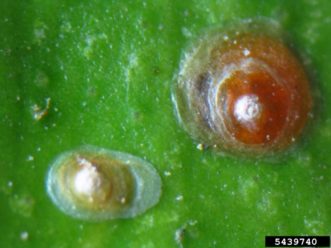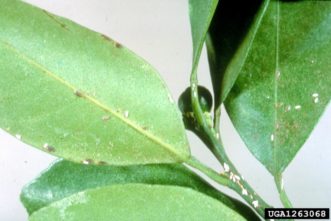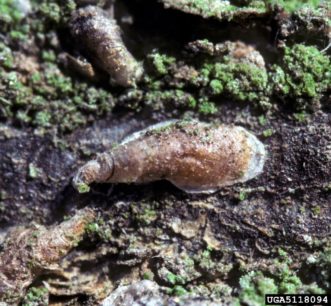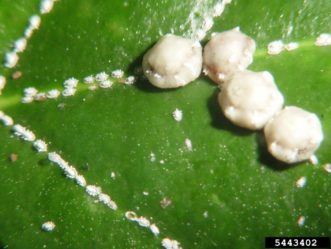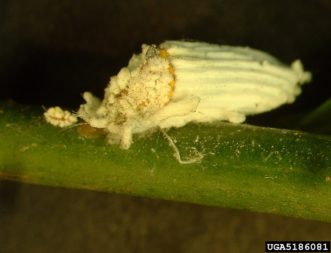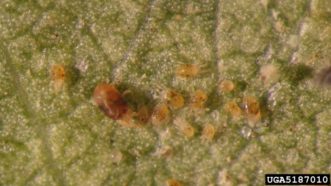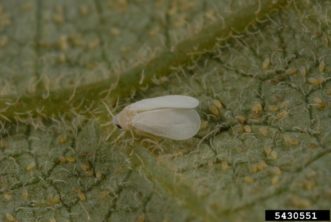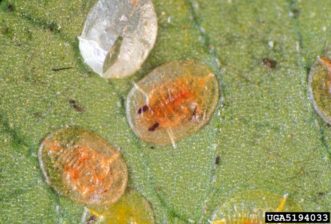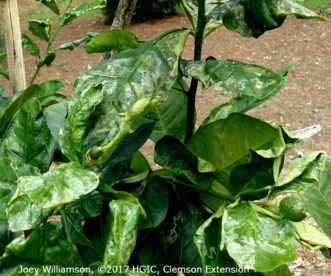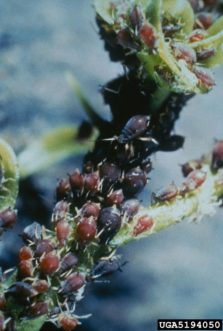A number of different insects and mites are common pests of citrus trees grown in South Carolina. Citrus pests identified by the Clemson Plant and Pest Diagnostic Clinic over the last few years have included various armored and soft scale insects, mites, whiteflies, leafminers, mealybugs, and aphids. The most problematic pests for containerized citrus grown indoors over the winter are spider mites and mealybugs.
To maintain a healthy citrus tree, such as this orange tree (Citrus x sinensis), one must be observant of insect pests that injure the foliage, twigs, and fruit and treat the pest problem accordingly.
Barbara Smith, ©2017 HGIC, Clemson Extension
Cultural Control & Prevention of Citrus Pests
Maintain good citrus tree health to reduce the chance and severity of scale infestation, and for the trees to better tolerate insect pests already present. Citrus under drought or nutrient stress are more susceptible to scale and other insect pest infestations, so maintain plant vigor. However, do not over-fertilize trees and shrubs, as this can lead to increased pest problems.
Have the soil tested to determine the soil pH and the nutrient content of the soil. Fertilize and lime according to the soil test results. In the absence of a soil test, fertilize citrus trees with a slow-release, citrus tree fertilizer or a slow-release tree & shrub fertilizer (such as a 12-6-6) once or twice in the spring, following fertilizer label rates. In counties along the coast, such as Horry, Beaufort, and Charleston, where high phosphorus levels naturally exist in the soils, use a 15-0-15 fertilizer for citrus trees. Avoid the temptation to over-fertilize trees and shrubs, as this can lead to increased pest problems. For information on how to test the soil, please see the fact sheet HGIC 1652, Soil Testing.
Water established citrus trees as needed, which is usually no more than once per week on established trees and monthly in the winter during periods of no rainfall. It is especially important to water trees during periods of heat and drought. Established trees require 1 inch of irrigation water per week during the growing season. Plants in containers may need water much more often. Allow potting soil in containers to become slightly dry between watering. Repot citrus plants in the spring as needed.
Mulch trees in the landscape with a 3-inch deep layer of an organic mulch (bark, pine needles, leaves, or compost), but do not pile the mulch against the trunk. Apply mulch out as far as the limbs extend.
Prune out heavily infested twigs or branches and promptly dispose of pruned material. This may significantly help to slow the infestation of scale insect pests. Also, be sure to inspect nearby shrubs and trees for these pests.
A high-pressure spray of water from the garden hose can be used to dislodge small pests, such as mites and aphids. For dislodging spider mites, direct the sprays upward toward the undersides of foliage. Indoor citrus houseplants may be taken outdoors during warm weather to spray with water or to allow rainfall to help dislodge mites.
Mature citrus trees (more than 4 years old) generally tolerate leaf damage by the citrus leafminer with little effect on tree growth or fruit yield. Citrus leafminer is likely to cause more damage in young citrus trees as foliar damage reduces their vigorous growth. Even heavy infestations of citrus leafminer on young trees are unlikely to cause tree death. Do not prune leaves damaged by citrus leafminer because undamaged areas of leaves will continue to produce food for the tree (unless the leafminers are only in a few leaves). Do not apply nitrogen fertilizer at the times of the year when leafminer populations are high, such as in the summer and fall, because a flush of new leaf growth may be damaged.
Caution: If citrus trees are growing in the lawn, keep broadleaf weed killers away, as these can injure or stress trees. Tree roots will extend outward under the turfgrass and can take up these herbicides. Harmful herbicide products include weed & feed fertilizers applied on nearby lawns.
Scale Insect Pests
The California red scale is an armored scale with a hard, reddish-brown covering over the adults. It can infest all parts of the plants.
Dennis Navea, ControlBest, Bugwood.org
California red scale (Aonidiella aurantii) is an armored scale pest of citrus and difficult to control with insecticides. The adult female scale infests the fruit, stems, and leaves, and appears as ⅟10-inch, reddish-brown spots or scabs on the plant. The female gives birth to 100 to 150 yellow-colored immatures, called crawlers, which disperse by crawling to find a place to settle down and suck nutrients from the plant parts. These crawlers form hard coverings over their bodies and become immobile adults.
Severe infestations cause leaf yellowing and drop, dieback of twigs and limbs, and occasionally death of the tree. Citrus tree damage is most likely to occur in late summer and early fall when populations of this scale are highest, and moisture stress on the tree is greatest. Naturally occurring parasitic insects may help control some of the scales in outdoor settings.
Citrus snow scale infests limbs and twigs initially, but with a severe infestation, this scale will colonize the foliage.
Central Science Laboratory, Harpenden, British Crown, Bugwood.org
Citrus snow scale (Unaspis citri) is an armored scale that is a sporadic pest and host specific on citrus trees. Heavy infestations can almost completely cover the bark and larger limbs and give a white, snowy appearance. The inconspicuous, immobile female scales are brownish-purple, oyster-shell shaped, and ⅟16– to ⅟11-inch long pests. The snow-white, winged males give the descriptive name to this scale species. Crawlers (immatures) are very small, light orange to reddish and easily spread to other plants and additional branches. Some or all life stages of the scale are found throughout the year (eggs, crawlers, nymphs, and adults). There are multiple generations of this scale during the growing season.
With infestation, citrus tree will have decreased vigor, reduced fruit production, and partial defoliation. Heavy infestations can cause limb and branch dieback, large cracks to form in the bark, and can eventually lead to the death of the tree. Typically, leaves and fruit are not infested until scale populations become severe. Natural parasitoids are unable to keep this scale pest under control.
Florida red scale initially infests citrus fruit and is one of the most damaging scale pests of citrus.
Pedro Torrent Chocarro, Bugwood.org
Florida red scale (Chrysomphalus aonidum) is an armored scale with circular armor made up of three concentric rings. They are dark reddish-brown, have a conspicuous, light brown center, and the size is about ⅟12-inch in diameter. This scale occurs on a wide range of hosts, such as citrus, Aspidistra, and Dracaena, and like most armored scales does not produce honeydew (the sugary waste product that drips from the insects). There may be several generations per year. The immatures (crawlers) are bright lemon yellow. They infest fruit first, and then in late summer and early fall, they feed on the foliage.
Symptoms consist of yellow spots on both the leaves and fruit. If only a few leaves are infested with scales, trim off and dispose of the infested foliage. If the citrus is a landscape plant, sprays are needed to stop the spread of this pest. Heavy infestation may cause severe defoliation. This scale pest is one of the most serious pests of citrus. There are several wasp parasites, which aid in the control of this scale. Additionally, ladybird beetles will feed on the scale crawlers.
Purple scale is also a serious pest of citrus and can infest all parts of the citrus trees. D.R. Miller, US National Collection of Scale Insects Photographs, USDA ARS, Bugwood.org
Purple scale (Lepidosaphes beckii) is an armored scale pest primarily of citrus trees. The adult female scales are small, elongate, ⅟12– to ⅟8-inch long, purple to dark brown, and slightly curved. The adult male scales are smaller. The mobile immatures are very small and white, and there may be two generations per year. This insect pest prefers the shadier and more protected areas of the tree, so the higher populations may be found toward the center of the tree. The dense canopy of foliage protects them from parasites.
This scale infests the citrus foliage, fruit, and stems, and can cause leaf yellowing and drop, spotting and deformity of fruit, shoot malformation, and with heavy infestations, plant death can occur. Symptoms include green spots on fruit that do not color correctly and yellow spots on foliage. A heavy infestation may cause defoliation. Parasitic wasps keep purple scale in check in Florida, but these biological controls may not yet be present in South Carolina.
Florida wax scale (Ceroplases floridensis) are small brownish-purple insects that are covered with a dirty-white waxy covering. They are soft scales that commonly infest citrus, hemlock, azalea, blueberry, camellia, Chinese elm, fig, Chinese holly, yaupon holly, jasmine, mulberry, pear, persimmon, plum quince and other plants. Crawlers (the immatures) are typically pink and are present during late spring or early summer. They migrate to and feed on the underside of foliage for about a month, at which time the female crawlers move to twigs and small branches to continue feeding.
Florida wax scale is a soft scale of citrus and many ornamentals. This scale produces honeydew, which drips onto surrounding foliage. The honeydew is colonized by dark-colored sooty mold and results in foliage becoming blackened.
Chazz Hesselein, Alabama Cooperative Extension System, Bugwood.org
When a scale infestation is heavy, black sooty mold can grow on the clear, sweet, sticky honeydew (the sugary waste product resulting from scale feeding on plant sap) that drips onto nearby foliage. Severe infestations may kill branches. If there is no noticeable blackening of the leaves from sooty mold, then the wax scale infestation is probably not severe enough to kill branches. Typically, natural enemies, such as parasitic wasps, keep Florida wax scale under control.
Cottony cushion scale (Icerya purchase) can be more than a nuisance on shrubs and trees. Host plants include citrus, apple, Nandina, Boston ivy, boxwood, cypress, hackberry, locust, maple, oaks, peaches and plums, pecan, pears, pine, Pittosporum, pomegranate, quince, rose, Verbena, walnut, willow, and other woody ornamentals.
Adult female scale insects have reddish-brown bodies with black legs and antennae. However, the most distinguishing characteristic of this scale is the large, elongated and grooved, cottony-white egg sac. The egg sac (⅜- to ⅝-inch in length) becomes two to 2½ times as long as the body of the female, and there may be hundreds of eggs in each egg sac. Eggs in the egg sac hatch into the six-legged “crawler” stage, which are bright red with black legs. They then move onto larger twigs and branches, feed, and develop through several stages before becoming adults. Populations may increase very quickly during the dryer months of summer.
Cottony cushion scale is another soft scale of citrus. Behind the female scale is a grooved, white egg sac containing hundreds of scale eggs.
Sonya Broughton, Dept. of Agriculture & Food, Western Australia, Bugwood.org
Cottony cushion scale infestations can generally cause older trees to have reduced vigor, premature leaf drop, or twig death, but younger trees can be severely stunted or killed. Similar to the Florida wax scale, these soft scale insects debilitate plants by sucking out sap (phloem), and then excrete honeydew, which coats infested plants. Dark fungi called sooty molds grow in the honeydew. Heavily infested trees become chlorotic and darkened by the mold. During periods of stress, leaves and fruit may drop prematurely, and plants may die.
Chemical Control of Scales: The adult female scales are difficult to control with regular contact insecticides because of their hard, waxy covering. However, sprays of horticultural oil, an excellent, proven product for scale control, kill all stages of scales insects that are present at the time of application. Horticultural oil is safe to use and is an especially good choice for sensitive areas, such as where people are present soon after treatment. Due to its short residual, oil sprays help to conserve beneficial insect species. Horticultural oil sprays control both armored and soft scales.
Apply a horticultural oil spray before new growth begins in late winter or early spring and when the temperatures are above 45 °F. These oils work by smothering overwintering adult female scales, immatures (crawlers), and their eggs. They offer the best control when applied during this dormant season. Oil sprays kill by suffocation. Spray the trunk and limbs with 2% horticultural oil solution to the point of run-off. Make a 2% solution by mixing 5 tablespoons of horticultural oil per gallon of water.
Horticultural oil sprays can be applied any time to control scales any time the temperatures are between 45 and 85 ºF. If scale problems are severe, spring and fall applications may be needed. Additional spray applications may be required when new leaves start to expand in the spring. Make two or more spring applications as necessary at three- to four-week intervals. These springtime sprays provide control of the immatures (crawlers) that hatch after new foliage appears. Spray the trees thoroughly until the oil spray drips or “runs off” from the upper and lower surfaces of leaves, twigs, branches, and the trunk.
When necessary, a 1 or 2% mixture of horticultural oil can be applied again to the foliage during the growing season. For tender new growth, apply a 1% mixture spray (2½ tablespoons per gallon of water). On mature foliage, apply a 2% mixture spray (5 tablespoons of oil per gallon of water). Do not spray in direct sunlight or if rainfall is expected within 24 hours. To lessen the chance of foliar injury and slow the drying time of the oil sprays, apply horticultural oils late in the day.
If citrus fruit are present on the plants, apply horticultural oil no stronger than 3 tablespoons per gallon of water. Shake the sprayer often to keep the oil and water mixed. Examples of horticultural oil products are in Table 1.
Canola oil sprays labeled for horticultural use can also be used to reduce the number of scale insect pests by suffocating all growth stages like the horticultural oil sprays do. Examples of available brands are in Table 1.
In general, using least toxic insecticides, like horticultural oil and canola oil, will prevent harm to beneficial insects. When general contact insecticides are used, they will kill the naturally occurring, beneficial enemies of scale insects. The general contact insecticides will only kill the crawler stage (immatures) of the scale insect because they cannot penetrate the hard waxy covering over the adults. Therefore, contact insecticides should only be applied during the growing season when scale crawlers are present. General contact insecticides registered for insect control on citrus include malathion. For examples of brands containing malathion, please see Table 1.
Mites
Citrus red mite is a cool season citrus pest, so populations are higher during the spring and fall.
Jim Baker, North Carolina State University, Bugwood.org
Citrus red mite (Panonychus citri) is more active on new growth of citrus plants, especially in the late spring and early fall. Populations will also be higher at these times of year because in the summer, the higher temperatures and humidity tend to reduce these cool season mite populations. Adult female citrus red mites are oval, globular-shaped and characteristically red. These mites feed on leaves, fruit, and green twigs of all citrus varieties. Leaf infestations are typically higher than those on the fruit. Citrus red mite produces little or no webbing on the plant.
The mite has piercing-sucking mouthparts, which it inserts into plant tissue. Injury resulting from this type of feeding appears as light-colored, scratched, or bleached areas, known as stippling. Stippling gives leaves and fruit a grayish or silvery appearance. Citrus red mites feeding and harsh weather can result in heavy leaf drop, twig dieback, and death of large limbs. Citrus red mite is a major pest of citrus worldwide causing considerable damage on lemon and grapefruit, and to a lesser extent on orange and tangerine. Other host plants include roses and pears.
Two-spotted spider mite is a summertime pest of citrus, but this mite will infest containerized citrus held indoors during the winter.
Sonya Broughton, Dept. of Agriculture & Food, Western Australia, Bugwood.org
Two-spotted spider mite (Tetranychus urticae) infestations usually start on the lower leaf surface. As the spider mite population grows, they often move to the upper leaf surface to feed. Citrus plants growing next to very warm surfaces, such as brick, stone, or concrete structures are more apt to become infested with two-spotted spider mites because the plants will be hotter and thus more stressed. Unlike the citrus red mite that prefers cooler temperatures, two-lined spider mites are more of a pest during the warmer summer months. However, they can become a year-round pest when containerized citrus plants are brought indoors during the winter.
Generally, a fine flecking or stippling is observed as the mites feed on the foliage. The mesophyll layer (the center layer) of the leaf collapses and the infested area becomes pale or grayish. A sure sign of a heavy spider mite infestation is large amounts of webbing found around the terminal ends of upright branches. A severe infestation may also cause defoliation. Two-spotted spider mites are also pests of many landscape shrubs and flowers.
When attempting to make a positive identification, spider mites can be detected by viewing the underside of leaves using a 10x or greater lens. Another detection method is to shake branches over a white piece of paper. Dislodged spider mites appear as little “specks” approximately the size of a period at the end of this sentence.
Chemical Control of Mites: Horticultural oil is safe to use and is an especially good choice for sensitive areas, such as where people are present soon after treatment. Because of the short residual, oil sprays help to conserve beneficial insect species. Horticultural oil sprays will control both citrus red mites and two-spotted spider mites.
Apply a horticultural oil spray before new growth begins in the late winter or early spring and when the temperature is above 45 °F. These oils work by smothering the overwintering mites and reduce populations before they can build up in the spring. These sprays kill by suffocation. Spray the trunk and limbs with 2% horticultural oil solution to the point of run-off. Make a 2% solution with 5 tablespoons of horticultural oil per gallon of water.
Horticultural oil sprays can be applied any time when temperatures are between 45 and 85 ºF. If the citrus red mite problem is serious, both spring and fall applications may be necessary. Apply spray applications when new leaves start to expand in the spring. Apply a 1% oil spray (2½ tablespoons oil per gallon of water). Make two or more applications as necessary at three- to four-week intervals. Spray the plants thoroughly until the mixture drips or “runs off” from the upper and lower surfaces of leaves, twigs, branches, and the trunk. Later in the growing season, when the temperatures become warmer, two-spotted spider mite populations may increase rapidly.
When necessary, apply a 2% mixture of horticultural oil spray to the mature foliage during the growing season (5 tablespoons of oil per gallon of water). Do not spray in direct sunlight, or if rainfall is expected within 24 hours. To lessen any chance of foliar injury and slow the drying time of the oil sprays, apply horticultural oil sprays late in the day.
Citrus grown as houseplants infested with two-spotted spider mites may be taken outdoors during mild temperatures for spray applications, then returned indoors when dry. Do not spray citrus that are in bloom. If citrus fruit are present on the plants, apply horticultural oil sprays that are no stronger than 3 tablespoons per gallon of water. Shake the sprayer often to be sure the mixture does not separate. For examples of horticultural oils, please see Table 1.
Canola oil sprays can also be applied to reduce the number of citrus red mites and two-spotted spider mites and is used like a horticultural oil spray. For examples of canola oil products, please see Table 1.
Insecticidal soap sprays are very effective against various mites and are most effective if applied when environmental conditions promote slow drying (i.e., early morning and early evening). Repeat applications in 5 days if more spider mites are found. Thorough coverage on the undersides of the leaves and new growth to the point of run-off is especially important when using soap sprays. Do not use insecticidal soap sprays when the citrus is in bloom. Follow label directions for mixing. For examples of insecticidal soap products, please see Table 1.
Whiteflies, Leafminers, Mealybugs, & Aphids
Citrus whitefly feed primarily the lower leaf surface of foliage. As they suck sap, the sugary waste product, called honeydew, is produced and drips onto surrounding foliage. Soon afterward, the honeydew is colonized by the dark-colored sooty mold.
Lyle Buss, University of Florida, Bugwood.org
Citrus whiteflies (Dialeurodes citri) have piercing-sucking mouthparts with which they puncture the leaf and suck the plant juices. The top sides of leaves on infested plants become pale or spotted due to these insects feeding on the undersides of the leaves. Whiteflies excrete large amounts of honeydew, a liquid sugary waste product, which drips onto foliage and provides an excellent medium for the growth of a black fungus called sooty mold. Besides being unattractive, sooty mold may interfere with photosynthesis and retard the growth of the plant. Sooty mold usually weathers away following control of the insect infestation.
Ants feed on the sugary honeydew excreted by piercing-sucking insects, such as whiteflies, aphids, and mealybugs. When ants are seen on citrus plants, the foliage should be examined closely for the presence of these insects Extensive feeding may cause leaf drop.
Citrus whiteflies can be detected by shaking a branch and watching for the small white adults as they fly away. Other whitefly species also may feed on citrus plants.
The citrus whitefly nymph is small and flat, and feeds on the lower leaf surface of citrus foliage, as does the adult.
Florida Division of Plant Industry, Florida Dept. of Agriculture & Consumer Services, Bugwood.org
Citrus leafminer (Phyllocnistis citrella) is a very small, light-colored moth that is less than ⅛-inch long. Female moths are attracted to the new succulent foliage on citrus trees and lay their eggs singly on the underside of leaves, particularly along the mid-vein. Eggs hatch about 4 to 5 days after being laid. Newly hatched citrus leafminer larvae begin feeding immediately in shallow, meandering mines or tunnels within young leaves. The larvae mine the lower or upper surface of the leaves causing them to curl and look distorted. The citrus leafminer most commonly feeds on most species of citrus, as well as closely related plants, such as kumquat and calamondin.
New leaves are the sites for egg laying by the citrus leafminer adult. The eggs hatch, and the immatures feed as they mine within these young, tender leaves. As the leaves expand, they become distorted.
Joey Williamson, ©2017 HGIC, Clemson Extension
Citrus mealybug (Planococcus citri) female and nymphs (immatures) are ⅛-inch or smaller. They are soft, flat, oval, and wingless insects with long tails and covered with white fluffy wax. Male insects are tiny and gnat-like with one pair of wings. Citrus mealybugs infest a wide variety of greenhouse, nursery, and landscape plants. They typically feed on above ground portions of plants at shoot crotches. If numerous, they may be found feeding on stems, foliage, and flowers.
Citrus mealybug is a pest of citrus, as well as many landscape and greenhouse plants. They primarily feed on foliage and tender stems.
J.A. Davidson, University of Maryland, College Park, Bugwood.org
Citrus mealybugs feed on plants from 27 plant families, including citrus, apple, English ivy, Ficus, Gardenia, Jasmine, Oleander, persimmon, Pittosporum, Canna, and Rhododendron. Other species of mealybugs may also infest citrus.
Citrus mealybug damage hosts by sucking out plant sap causing wilt, distorted or stunted growth, yellowed (chlorotic) leaves, premature leaf drop, and occasionally death. They also secrete an unattractive cottony wax. Like other piercing-sucking insects above, mealybugs excrete large amounts of honeydew. This sugary waste becomes colonized by sooty mold causing leaves to look dark and unsightly. Mealybugs have many naturally occurring parasites and predators.
Black citrus aphid (Toxoptera aurantii) is another common insect pest of citrus. This aphid also infests Camellia, Ixora, sugar maple, Pittosporum, crape myrtle, and Elaeagnus in the Southern United States.
These brown citrus aphids are very similar in appearance to the black citrus aphid, which feeds on flowers buds and new foliage of citrus.
Florida Division of Plant Industry, Florida Dept. of Agriculture & Consumer Services, Bugwood.org
Black citrus aphid is most abundant in early spring and typically congregates on flower buds. They will also feed on young developing foliage resulting in leaf cupping, curling, and twisting. As with all aphid feeding, the production of honeydew results in the growth of the black sooty mold on leaves. Other species of aphids also feed on citrus. Aphids are often kept under control by the many natural predators and parasites.
Chemical Control of Whiteflies, Leafminers, Mealybugs, & Aphids: Horticultural oil sprays will control whiteflies, mealybugs, and aphids, but not leafminers. On citrus trees, apply horticultural oil sprays when pests are present, and when temperatures are between 45 and 85 ºF. However, they will not work preventatively, as they kill by suffocation as the oil sprays cover the pest. Spray the trunk, limbs, and mature foliage with 2% horticultural oil solution to the point of run-off. Make a 2% solution by adding 5 tablespoons of horticultural oil per gallon of water.
If pests are present during spring as new, tender growth appears, apply a 1% mixture spray (2½ tablespoons oil per gallon of water). Apply two more spring applications as necessary at three- to four-week intervals. Spray the plants thoroughly, so that the oil mixture drips or “runs off” from the upper and lower surfaces of leaves, twigs, branches, and the trunk. Do not spray in direct sunlight, or if rainfall is expected within the next 24 hours. To lessen any chance of foliar injury and slow the drying time of the oil sprays, apply horticultural oils late in the day.
Citrus grown as houseplants that are infested with whiteflies, mealybugs, or aphids can be taken outdoors during mild temperatures for spray applications, and then returned indoors after they are dry. Do not spray citrus trees that are in bloom.
If citrus fruit are present on the plants, apply horticultural oil mixtures no stronger than 3 tablespoons per gallon of water. Shake the sprayer often to be sure the oil and water mixture do not separate. For examples of horticultural oil products, please see Table 1.
Canola oil sprays can also be used to reduce the number of whiteflies, mealybugs, and aphids. For examples of canola oil products, please see Table 1.
Insecticidal soap sprays are also very effective against whiteflies, mealybugs, and aphids. These sprays work better if applied when environmental conditions promote slow drying (i.e., early morning and early evening). Repeat spray applications in 5 days if necessary. Thorough coverage on the undersides of the leaves and new growth to the point of run-off is especially important when using soap sprays. Do not use insecticidal soap sprays when the citrus is in bloom.
Mealybugs are more apt to be a problem with indoor citrus trees. Containerized citrus plants can be moved outside during mild weather to spray them with an insecticidal soap. Follow label directions for mixing and spray trees to the point of run off. For examples of insecticidal soap products, please see Table 1.
Spinosad is a natural insecticide that has the ability to penetrate the foliage (i.e., it is a foliar systemic) and will control citrus leafminer larvae within the leaves. For examples of products containing Spinosad, please see Table 1.
Table 1. Insecticides for Citrus Insect Pest Control in the Home Landscape.
| Pesticide Active Ingredient | Brand Names & Products |
| Horticultural oil1 & canola oil1 | Bonide All Seasons Spray Oil Concentrate Ferti-lome Horticultural Oil Spray Concentrate Monterey Horticultural Oil Concentrate Southern Ag ParaFine Horticultural Oil Concentrate Summit Year Round Spray Oil Concentrate Espoma Earth-tone Horticultural Oil Concentrate (canola); & RTS2 |
| Insecticidal soap3 | Bonide Insecticidal Soap Concentrate Espoma Earth-tone Insecticidal Soap Concentrate Natural Guard Insecticidal Soap Concentrate Safer Brand Insect Killing Soap Concentrate II Garden Safe Insecticidal Soap Insect Killer Concentrate |
| Malathion | Bonide Malathion Insect Control 50% Concentrate Ortho Max Malathion Insect Spray Concentrate Spectracide Malathion Insect Spray Concentrate Southern Ag Malathion 50% EC Southern Ag Malathion – Oil Citrus & Ornamental Spray Concentrate |
| Spinosad | Bonide Colorado Potato Beetle Beater Concentrate Bonide Captain Jack’s Dead Bug Brew Concentrate; & RTS2 Ferti-lome Borer, Bagworm & Leafminer Spray Concentrate Monterey Garden Insect Spray Concentrate Natural Guard Spinosad Bagworm, Tent Caterpillar, & Chewing Insect Control Concentrate; & RTS2 Southern Ag Conserve Naturalyte Insect Control Concentrate |
| |
Pesticides are updated annually. Last updates were done on 8/19 by Joey Williamson.
Originally published 07/17
If this document didn’t answer your questions, please contact HGIC at hgic@clemson.edu or 1-888-656-9988.

